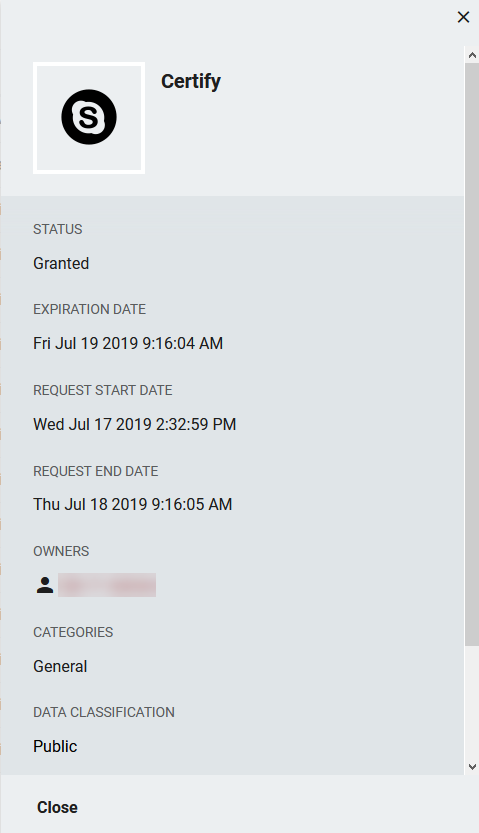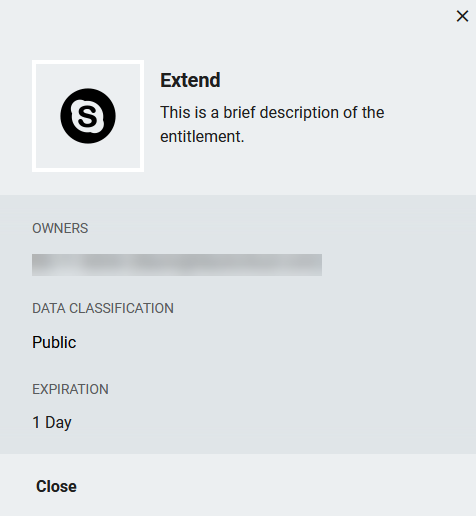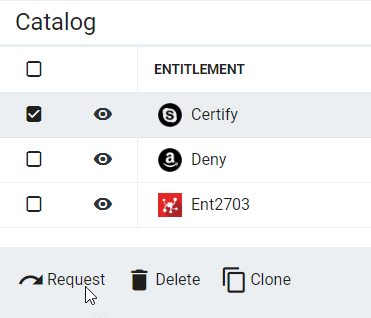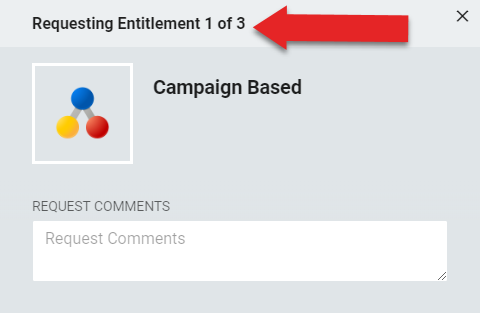Entitlements
The Entitlements section contains two categories: My Entitlements and Catalog.
An Entitlement is an abstracted representation of one or more levels of access to one or more systems. Entitlements are managed within RapidIdentity by an administrator or a user with added permissions. An Entitlement assignment to an Identity should result in RapidIdentity updating that system to enable the appropriate access for the recipient when granted. An Entitlement can represent an Account, Memberships (group or roles) and/or Permissions in a local system.
Entitlements can include various configurations that can help define its function and the person or groups, along with specific attributes who can request them.
My Entitlements
The My Entitlements interface allows users the ability to view details associated with any entitlements that have ever been requested on behalf of the user and the current state of each request. The initial view displays the expiration date (if applicable) of the entitlement, along with the categories that they pertain to and the data classification. My Entitlements displays all entitlements, in which action has previously been taken on. This includes each time an entitlement has been granted, revoked, denied, failed, or if it is pending.
Users can choose either of two display options to view entitlements: List or Grid.
The List view provides an entitlement table allowing users to view the entitlement expiration date, category, and data classification.
Users can also click History to view their history with a particular entitlement and Details to view any configured information provided with that entitlement or with the entitlement request.
The list view also provides icons to display the status of an entitlement request.
See Table 1 for a list of icons and their descriptions.
Icon | Icon Status | Icon State Description |
|---|---|---|
 | Not Associated | Whitespace is used to indicate that there is no association between the user and the entitlement. |
 | Revoked | The undo icon is used to indicate that an entitlement has been revoked. |
 | Pending | The rotate right icon is used to indicate:
NoteThis icon indicates that this entitlement request is pending additional action from an administrator or user with permissions. |
 | Granted | A check icon is used to indicate:
|
 | Grant Denied | An X icon is used to indicate:
|
When an entitlement is selected, the user has the ability to view its History, or Revoke it, depending on its status. Additionally, active entitlements can be revoked by clicking the Revoke button located at the end of the row that houses the entitlement. Details can also be viewed from this location. The user also has the ability of printing a list of all of their entitlements in the My Entitlements section by clicking the Print button.
The Details section contains two tabs: Details and Entitled Users.
 |
The information found in the details section is dependent on the information that was included while being created.
Table 2 displays the fields commonly displayed in the Details tab and a brief description.
Field Name | Description |
|---|---|
Icon | Icon associated with the entitlement. |
Name | Name provided as an entitlement descriptor. |
Description | A brief description of the entitlement. This element will display if the entitlement was initially provided a description. |
Status | The status of the entitlement in association to the user. |
Request Start Date | Displays the date in which the entitlement was initially requested by the user. |
Request End Date | Will display the time the entitlement request was approved, denied, or revoked. |
Owners | Displays the owner of the entitlement. |
Categories | Displays categorization of the entitlement. |
Data Classification | The Data Classification associated with the Entitlement. This is predetermined during the creation of the entitlement and will display who has access to view the entitlement. |
Approval History | Displays the history of the approval and its associated comments, if any. If the entitlement requires a manager approval, this will step will also be displayed as it gets approved. |
Catalog
The Catalog interface allows users to request and view details of entitlements.
The user can only request those entitlements that show available to request.
Entitlement Status Symbol | Symbol Function | |
|---|---|---|
| The "eye" symbol indicates that the entitlement is active. | |
| The "strikethrough eye" indicates that the entitlement is inactive. |
The checkbox allows an entitlement to be selected. The Request button appears in the footer when one or more entitlements are selected at a given time.
Entitlement details can be viewed by clicking Details.
 |
The Details section displays the icon, name, description (if one was provided), owners, data classification, and expiration date (if applicable) of the entitlement.
Request an Entitlement
Entitlements can be requested in the Catalog interface. The overall functionality is similar to the Requests tab in the RapidIdentity Portal Workflows module in the legacy user interface, with the primary exception being that Requests is now accessed through the Module Selector in the Top Navigation Bar, rather than as a tab under the Workflows module.
Follow these two steps to request an entitlement.
Adding text and comments to the request is optional. Click Request.
Select an entitlement and click Request.

More than one entitlement can be requested at a time. Users can select multiple entitlements and click Request. The Request dialog allows each entitlement to be requested separately and users can optionally add comments to each request.
 |

